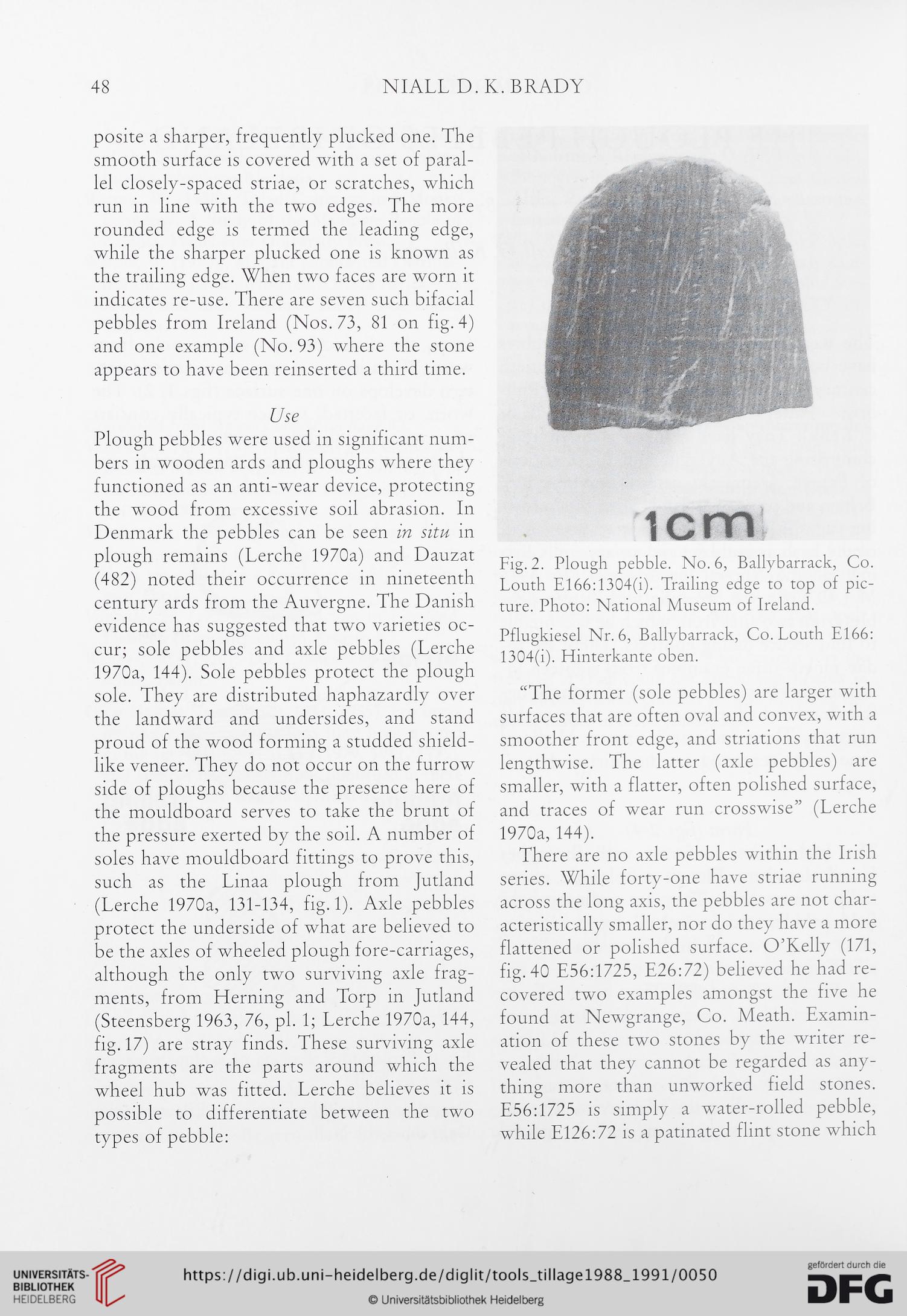48
NIALL D. K. BRADY
posite a sharper, frequently plucked one. The
smooth surface is covered with a set of paral-
lel closely-spaced striae, or scratches, which
run in line with the two edges. The more
rounded edge is termed the leading edge,
while the sharper plucked one is known as
the trailing edge. When two faces are worn it
indicates re-use. There are seven such bifacial
pebbles from Ireland (Nos. 73, 81 on fig. 4)
and one example (No. 93) where the stone
appears to have been reinserted a third time.
Use
Plough pebbles were used in significant num-
bers in wooden ards and ploughs where they
functioned as an anti-wear device, protecting
the wood from excessive soil abrasion. In
Denmark the pebbles can be seen in situ in
plough remains (Lerche 1970a) and Dauzat
(482) noted their occurrence in nineteenth
century ards from the Auvergne. The Danish
evidence has suggested that two varieties oc-
cur; sole pebbles and axle pebbles (Lerche
1970a, 144). Sole pebbles protect the plough
sole. They are distributed haphazardly over
the landward and undersides, and stand
proud of the wood forming a studded shield-
like veneer. They do not occur on the furrow
side of ploughs because the presence here of
the mouldboard serves to take the brunt of
the pressure exerted by the soil. A number of
soles have mouldboard fittings to prove this,
such as the Linaa plough from Jutland
(Lerche 1970a, 131-134, fig. 1). Axle pebbles
protect the underside of what are believed to
be the axles of wheeled plough fore-carriages,
although the only two surviving axle frag-
ments, from Herning and Torp in Jutland
(Steensberg 1963, 76, pl. 1; Lerche 1970a, 144,
fig. 17) are stray finds. These surviving axle
fragments are the parts around which the
wheel hub was fitted. Lerche believes it is
possible to differentiate between the two
types of pebble:
icm
Fig. 2. Plough pebble. No. 6, Ballybarrack, Co.
Louth E166:1304(i). Trailing edge to top of pic-
ture. Photo: National Museum of Ireland.
Pflugkiesel Nr. 6, Ballybarrack, Co. Louth E166:
1304(i). Hinterkante oben.
“The former (sole pebbles) are larger with
surfaces that are often oval and convex, with a
smoother front edge, and striations that run
lengthwise. The latter (axle pebbles) are
smaller, with a flatter, often polished surface,
and traces of wear run crosswise” (Lerche
1970a, 144).
There are no axle pebbles within the Irish
series. While forty-one have striae running
across the long axis, the pebbles are not char-
acteristically smaller, nor do they have a more
flattened or polished surface. O’Kelly (171,
fig. 40 E56:1725, E26:72) believed he had re-
covered two examples amongst the five he
found at Newgrange, Co. Meath. Examin-
ation of these two stones by the writer re-
vealed that they cannot be regarded as any-
thing more than unworked field stones.
E56:1725 is simply a water-rolled pebble,
while E126:72 is a patinated flint stone which
NIALL D. K. BRADY
posite a sharper, frequently plucked one. The
smooth surface is covered with a set of paral-
lel closely-spaced striae, or scratches, which
run in line with the two edges. The more
rounded edge is termed the leading edge,
while the sharper plucked one is known as
the trailing edge. When two faces are worn it
indicates re-use. There are seven such bifacial
pebbles from Ireland (Nos. 73, 81 on fig. 4)
and one example (No. 93) where the stone
appears to have been reinserted a third time.
Use
Plough pebbles were used in significant num-
bers in wooden ards and ploughs where they
functioned as an anti-wear device, protecting
the wood from excessive soil abrasion. In
Denmark the pebbles can be seen in situ in
plough remains (Lerche 1970a) and Dauzat
(482) noted their occurrence in nineteenth
century ards from the Auvergne. The Danish
evidence has suggested that two varieties oc-
cur; sole pebbles and axle pebbles (Lerche
1970a, 144). Sole pebbles protect the plough
sole. They are distributed haphazardly over
the landward and undersides, and stand
proud of the wood forming a studded shield-
like veneer. They do not occur on the furrow
side of ploughs because the presence here of
the mouldboard serves to take the brunt of
the pressure exerted by the soil. A number of
soles have mouldboard fittings to prove this,
such as the Linaa plough from Jutland
(Lerche 1970a, 131-134, fig. 1). Axle pebbles
protect the underside of what are believed to
be the axles of wheeled plough fore-carriages,
although the only two surviving axle frag-
ments, from Herning and Torp in Jutland
(Steensberg 1963, 76, pl. 1; Lerche 1970a, 144,
fig. 17) are stray finds. These surviving axle
fragments are the parts around which the
wheel hub was fitted. Lerche believes it is
possible to differentiate between the two
types of pebble:
icm
Fig. 2. Plough pebble. No. 6, Ballybarrack, Co.
Louth E166:1304(i). Trailing edge to top of pic-
ture. Photo: National Museum of Ireland.
Pflugkiesel Nr. 6, Ballybarrack, Co. Louth E166:
1304(i). Hinterkante oben.
“The former (sole pebbles) are larger with
surfaces that are often oval and convex, with a
smoother front edge, and striations that run
lengthwise. The latter (axle pebbles) are
smaller, with a flatter, often polished surface,
and traces of wear run crosswise” (Lerche
1970a, 144).
There are no axle pebbles within the Irish
series. While forty-one have striae running
across the long axis, the pebbles are not char-
acteristically smaller, nor do they have a more
flattened or polished surface. O’Kelly (171,
fig. 40 E56:1725, E26:72) believed he had re-
covered two examples amongst the five he
found at Newgrange, Co. Meath. Examin-
ation of these two stones by the writer re-
vealed that they cannot be regarded as any-
thing more than unworked field stones.
E56:1725 is simply a water-rolled pebble,
while E126:72 is a patinated flint stone which




